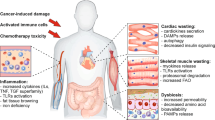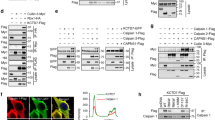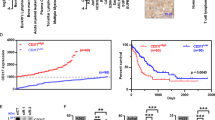Abstract
Cachexia is a syndrome characterized by profound tissue wasting that frequently complicates malignancies. In a cancer cachexia model we have shown that protein depletion in the skeletal muscle, which is a prominent feature of the syndrome, is mostly due to enhanced proteolysis. There is consensus on the views that the ubiquitin/proteasome pathway plays an important role in such metabolic response and that cytotoxic cytokines such as TNFα are involved in its triggering (Costelli and Baccino, 2000), yet the mechanisms by which the relevant extracellular signals are transduced into protein hypercatabolism are largely unknown. Moreover, little information is presently available as to the possible involvement in muscle protein waste of the Ca2+-dependent proteolysis, which may provide a rapidly activated system in response to the extracellular signals. In the present work we have evaluated the status of the Ca2+-dependent proteolytic system in the gastrocnemius muscle of AH-130 tumour-bearing rats by assaying the activity of calpain as well as the levels of calpastatin, the natural calpain inhibitor, and of the 130 kDa Ca2+-ATPase, both of which are known calpain substrates. After tumour transplantation, total calpastatin activity progressively declined, while total calpain activity remained unchanged, resulting in a progressively increasing unbalance in the calpain/calpastatin ratio. A decrease was also observed for the 130 kDa plasma membrane form of Ca2+-ATPase, while there was no change in the level of the 90 kDa sarcoplasmic Ca2+-ATPase, which is resistant to the action of calpain. Decreased levels of both calpastatin and 130 kDa Ca2+-ATPase have been also detected in the heart of the tumour-bearers. These observations strongly suggest that Ca2+-dependent proteolysis was activated in the skeletal muscle and heart of tumour-bearing animals and raise the possibility that such activation may play a role in sparking off the muscle protein hypercatabolic response that characterizes cancer cachexia. © 2001 Cancer Research Campaign
Similar content being viewed by others
Article PDF
Change history
16 November 2011
This paper was modified 12 months after initial publication to switch to Creative Commons licence terms, as noted at publication
References
Baracos VE, De Vivo C, Hoyle DH and Goldberg AL (1995) Activation of the ATP-ubiquitin-proteasome pathway in skeletal muscle of cachectic rats bearing a hepatoma. Am J Physiol 268: E996–E1006
Beck SA, Smith KL and Tisdale MJ (1991) Anticachectic and antitumour effect of eicosapentenoic acid and its effect on protein turnover. Cancer Res 51: 6089–6093
Bick RJ, Liao JP, King TW, LeMaistre A, McMillin JB and Buja LM (1997) Temporal effects of cytokines on neonatal cardiac myocyte Ca2+ transients and adenylate cyclase activity. Am J Physiol 272: H1937–H1944
Busquets S, Garcia-Martinez C, Alvarez B, Carbó N, López-Soriano FJ and Argilés JM (2000) Calpain-3 gene expression is decreased during experimental cancer cachexia. Biochim Biophys Acta 1475: 5–9
Calman KC (1992) Cancer cachexia. In: Oxford Textbook of Pathology, McGee JO’D, Isaacson PG, Wright NA (eds) pp. 715–717, Oxford University Press: Oxford
Carafoli E and Molinari M (1998) Calpain: a protease in search of function?. Biochem Biophys Res Commun 247: 193–203
Costelli P and Baccino FM (2000) Cancer cachexia: from experimental models to patient management. Curr Op Clin Nutr Metab Care 3: 177–181
Costelli P, Carbó N, Tessitore L, Bagby GJ, Lopez-Soriano FJ, Argilés JM and Baccino FM (1993) Tumor necrosis factor-alpha mediates changes in tissue protein turnover in a rat cancer cachexia model. J Clin Invest 92: 2783–2789
Das KC, Lewis-Molock Y and White CW (1995) Activation of NF-kappa B and elevation of MnSOD gene expression by thiol reducing agents in lung adenocarcinoma (A549) cells. Am J Physiol 269: L588–L602
De Smedt H, Eggermont JA, Wuytack F, Parys JB, Van Den Bosch L, Missiaen L, Verbis J and Casteels R (1991) Isoform switching of the sarco(endo)plasmic reticulum Ca2+pump during differentiation of BC3H1 myoblasts. J Biol Chem 266: 7092–7095
Furukawa K and Mattson MP (1998) The transcription factor NF-kappaB mediates increases in calcium currents and decreases in NMDA-and AMPA/kainate-induced currents induced by tumor necrosis factor-alpha in hippocampal neurons. J Neurochem 70: 1876–1886
Hirai S, Kawasaki H, Yaniv M and Suzuki K (1991) Degradation of transcription factors, c-Jun and c-Fos, by calpain. FEBS Lett 287: 57–61
Jones PL, Ping D and Boss JM (1997) Tumor necrosis factor alpha and interleukin-1beta regulate the murine manganese superoxide dismutase gene through a complex intronic enhancer involving C/EBP-beta and NF-kappaB. Mol Cell Biol 17: 6970–6981
Kien CL and Camitta BM (1983) Increased whole-body protein turnover in sick children with newly diagnosed leukemia or lymphoma. Cancer Res 43: 5586–5592
Kien CL and Camitta BM (1987) Close association of accelerated rates of whole-body protein turnover (synthesis and breakdown) and energy expenditure in children with newly diagnosed acute lymphocytic leukemia. J Parent Ent Nutr 11: 129–134
Kinbara K, Sorimachi H, Ishiura S and Suzuki K (1998) Skeletal muscle-specific calpain p94. Structure and function. Biochem Pharmacol 56: 20106–20111
Liu ZQ, Kunimatsu M, Yang JP, Ozaki Y, Sasaki M and Okamoto T (1996) Proteolytic processing of nuclear factor kB by calpain in vitro. FEBS Lett 385: 109–113
Llovera M, Garcia-Martinez C, Agell N, Lopez-Soriano FJ and Argiles JM (1995) Muscle wasting associated with cancer cachexia is linked to an important activation of the ATP-dependent ubiquitin-mediated proteolysis. Int J Cancer 61: 138–141
Llovera M, Carbó N, Garcia-Martinez C, Costelli P, Tessitore L, Baccino FM, Agell N, Bagby GJ, Lopez-Soriano FJ and Argiles JM (1996) Anti-TNF treatment reverts increased muscle ubiquitin gene expression in tumour-bearing rats. Biochem Biophys Res Commun 221: 653–655
Lundholm K, Ekman L, Karlberg I, Edström S and Scherstèn T (1980) Comparison of hepatic cathepsin D activity in response to tumor growth and to caloric restriction in mice. Cancer Res 40: 1680–1685
Melloni E, Pontremoli S, Michetti M, Sacco O, Sparatore B and Horecker BL (1986) The involvement of calpain in the activation of protein kinase C in neutrophils stimulated by phorbol myristic acid. J Biol Chem 61: 4101–4105
Melville S, McNurlan MA, Graham-Calder A and Garlick PJ (1990) Increased protein turnover despite normal energy metabolism and responses to feeding in patients with lung cancer. Cancer Res 50: 1125–1131
Nath R, Raser KJ, Stafford D, Hajikohammadreza I, Posner A, Allen H, Talanian RV, Yuen P, Gilbertsen RB and Wang KK (1996). Biochem J 319: 683–690
Niggli V, Penniston JT and Carafoli E (1979) Purification of the (Ca2+-Mg2+)-ATPase from human erythrocyte membranes using a calmodulin affinity column. J Biol Chem 254: 9955–9958
Pontremoli S, Melloni E, Salamino F, Sparatore B, Viotti PL, Michetti M, Duzzi L and Bianchi G (1986) Decreased level of calpain inhibitor activity in red blood cells from Milan hypertensive rats. Biochem Biophys Res Commun 138: 1370–1375
Pontremoli S, Melloni E, Sparatore B, Pontremoli R, Tizianello A, Barlassina Cusi D, Colombo R and Bianchi G (1988) Erythrocyte deficiency in calpain inhibitor activity in essential hypertension. Hypertension 12: 474–479
Pontremoli S, Melloni E, Viotti PL, Michetti M, Salamino F and Horecker BL (1991) Identification of two calpastatin forms in rat skeletal muscle and their susceptibility to digestion by homologous calpains. Arch Biochem Biophys 288: 646–652
Pontremoli S, Viotti PL, Michetti M, Salamino F, Sparatore B and Melloni E (1992) Modulation of inhibitory efficiency of rat skeletal muscle calpastatin by phosphorylation. Biochem Biophys Res Commun 187: 751–759
Richard Y, Brous O, Allamand V, Fougerousse F, Chiannikulchai N, Bourg N, Bernguier L, Devaud C, Pasturaud P, Rodaut C, Hillaire D, Passos-Bueno M, Zatz M, Tishfield J, Fardeau M, Jackson C and Beckmann JS (1995) Mutations in the proteolytic enzyme calpain-3 cause limb-girdle muscular dystrophy type 2A. Cell 81: 27–40
Salamino F, De Tullio R, Mengotti P, Viotti PL, Melloni E and Pontremoli S (1992) Different susceptibility of red cell membrane proteins to calpain degradation. Arch Biochem Biophys 298: 287–292
Salamino F, De Tullio R, Michetti M, Mengotti P, Melloni E and Pontremoli S (1994a) Modulation of calpastatin specificity in rat tissues by reversible phosphorylation and dephosphorylation. Biochem Biophys Res Commun 199: 1326–1332
Salamino F, Sparatore B, Melloni E, Michetti M, Viotti PL, Pontremoli S and Carafoli E (1994b) The plasma membrane calcium pump is the preferred calpain substrate within the erythrocyte. Cell Calcium 15: 28–35
Soeter PB and Baracos VE (1999) Anabolic and catabolic mediators. Curr Op Clin Nutr Metab Care 2: 195–199
Temparis S, Asensi M, Taillandier D, Aurousseau E, Larbaud D, Obled A, Bechet D, Ferrara M, Estrela JM and Attaix D (1994) Increased ATP-ubiquitin-dependent proteolysis in skeletal muscles of tumor-bearing rats. Cancer Res 54: 5568–5573
Tessitore L, Bonelli G and Baccino FM (1987) Early development of protein metabolic perturbations in the liver and skeletal muscle of tumour-bearing rats. Biochem J 241: 153–159
Tessitore L, Costelli P and Baccino FM (1993a) Humoral mediation for cancer cachexia in tumour-bearing rats. Br J Cancer 67: 15–23
Tessitore L, Costelli P, Bonetti G and Baccino FM (1993b) Cancer cachexia, malnutrition, and tissue protein turnover in experimental animals. Arch Biochem Biophys 306: 52–58
Tisdale MJ (1997) Biology of cachexia. J Natl Cancer Inst 89: 1763–1773
Vezzoli G, Elli AA, Tripodi G, Bianchi G and Carafoli E (1985) Calcium ATPase in erythrocytes of spontaneously hypertensive rats of the Milan strain. J Hypertens 3: 645–648
Watt F and Molloy PL (1993) Specific cleavage of transcription factors by the thiol protease, m-calpain. Nucleic Acid Res 21: 5092–6000
Williams A, Sun X, Fisher JE and Hasselgren PO (1999a) The expression of genes in the ubiquitin-proteasome proteolytic pathway is increased in skeletal muscle from patients with cancer. Surgery 126: 744–750
Williams AB, Decourten-Myers GM, Fischer JE, Luo G, Sun X and Hasselgren PO (1999b) Sepsis stimulates release of myofilaments in skeletal muscle by a calcium-dependent mechanism. FASEB J 1: 1435–1443
Yoshida Y, Shiga T and Imai S (1990) Degradation of sarcoplasmic reticulum calcium-pumping ATPase in ischemic-reperfused myocardium: role of calcium-activated neutral protease. Basic Res Cardiol 85: 495–507
Author information
Authors and Affiliations
Rights and permissions
From twelve months after its original publication, this work is licensed under the Creative Commons Attribution-NonCommercial-Share Alike 3.0 Unported License. To view a copy of this license, visit http://creativecommons.org/licenses/by-nc-sa/3.0/
About this article
Cite this article
Costelli, P., Tullio, R., Baccino, F. et al. Activation of Ca2+-dependent proteolysis in skeletal muscle and heart in cancer cachexia. Br J Cancer 84, 946–950 (2001). https://doi.org/10.1054/bjoc.2001.1696
Received:
Accepted:
Published:
Issue date:
DOI: https://doi.org/10.1054/bjoc.2001.1696
Keywords
This article is cited by
-
Cancer cachexia: molecular mechanisms and treatment strategies
Journal of Hematology & Oncology (2023)
-
Cardiac Complications: The Understudied Aspect of Cancer Cachexia
Cardiovascular Toxicology (2022)
-
Pay attention to cardiac remodeling in cancer cachexia
Supportive Care in Cancer (2016)
-
Neuroprotective Effect of Calpeptin on Acrylamide-Induced Neuropathy in Rats
Neurochemical Research (2015)
-
Cancer cachexia: impact, mechanisms and emerging treatments
Journal of Cachexia, Sarcopenia and Muscle (2013)



